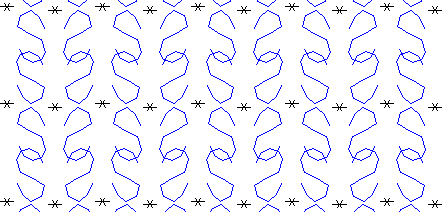Up: Table of Contents
Prev: Kali Exercise
Homework -- Searching for Symmetries

- Following the
directions from the in class
exercise, write down the symbols in the orbifold notation that
describe the patterns shown in figures 1, 4, 5, 6, 7, and 10 on the introduction and definitions pages of this section.
Support your answer by describing the features of the pattern
corresponding to each character in the notation.
Example: The orbifold notation for the pattern shown above is 22*.
The first sort of two-fold gyration point is in the center of the loop
where the two S's meet. The second type lies between the top of one S
and the bottom of one above it. The vertical columns of S's are
separated by parallel lines of mirror symmetry.
- Read the American Mathematical Monthly article on "The Plane
Symmetry Groups" by Doris Schattschneider. Identify some passage in
the article that was hard for you to understand. How did it make you
feel? How did you deal with it? Did you skip past that section,
puzzle over it, or refer to some other reference material? Try to
relate your experience to that of a student reading a geometry text.
- Using Kali or some other method, create wallpaper patterns that
illustrate each of the terms defined on the
definitions page, except for
"handle/wonder ring" and "cross cap/miracle". Can you find a way to
label each gyration point, distinguishing the different types? What
about mirror strings?
- Design a pattern whose symmetry group has orbifold notation 2*22.
You know from the in class exercise
that it will have some lines of mirror reflection and that those lines
will meet in pairs in two different ways. You also know that it has
to have a gyration point at which it's symmetric under rotations of
2
![[pi]](pi.gif) /2 radians (180 degrees), and that every
gyration point and kaliedoscopic point in the pattern will be one of
those mentioned above.
/2 radians (180 degrees), and that every
gyration point and kaliedoscopic point in the pattern will be one of
those mentioned above.
Use The Geometer's Sketchpad to generate a picture of your pattern.
Clearly label the two different types of kaleidoscopic point and the
one type of gyration point.
- Write a half- to one- page outline for a pre-college class in
which you would use Kali or The Geometric Golfer. What activities
would you do to prepare your students for this class? What are the
advantages of using computers in your class, as opposed to doing
hands-on activities with mirrors or printed patterns? What are the
disadvantages?
- Today's exercise made use of a Web page that wasn't written
specifically for the course. The advantages of this are clear -- we
avoided "re-inventing the wheel" by recycling someone else's work.
The disadvantages are (hopefully) not as clear. Other peoples' Web
pages can move, be deleted, or contain obscenities or copyright
violations. Also, other peoples' pages generally aren't written
for the precise grade level and topic that you want to teach.
The ability to connect to and reference pages of others' work is one
of the great strengths of hypertext documents. How would you deal
with the weaknesses discussed above when producing your own Web pages?
What other strengths and weaknesses of hypertext can you think of, and
how might you exploit or avoid them in your own work? How can you
configure your own Web pages to make them more useful to others who
might want to refer to them? You may find yourself needing the
answers to these questions when working on your final project!
Up: Table of Contents
Prev: Kali Exercise
![[HOME]](/pix/home.gif) The Geometry Center Home Page
The Geometry Center Home Page
Author: Heidi Burgiel, adapted from notes
used in Math 5337, Spring 1995 by Chaim
Goodman-Strauss.
Comments to:
webmaster@geom.umn.edu
Created: Dec 21 1995 ---
Last modified: Jun 11 1996
Copyright © 1995-1996 by
The Geometry Center
All rights reserved.

![[pi]](pi.gif) /2 radians (180 degrees), and that every
gyration point and kaliedoscopic point in the pattern will be one of
those mentioned above.
/2 radians (180 degrees), and that every
gyration point and kaliedoscopic point in the pattern will be one of
those mentioned above.
![[HOME]](/pix/home.gif) The Geometry Center Home Page
The Geometry Center Home Page